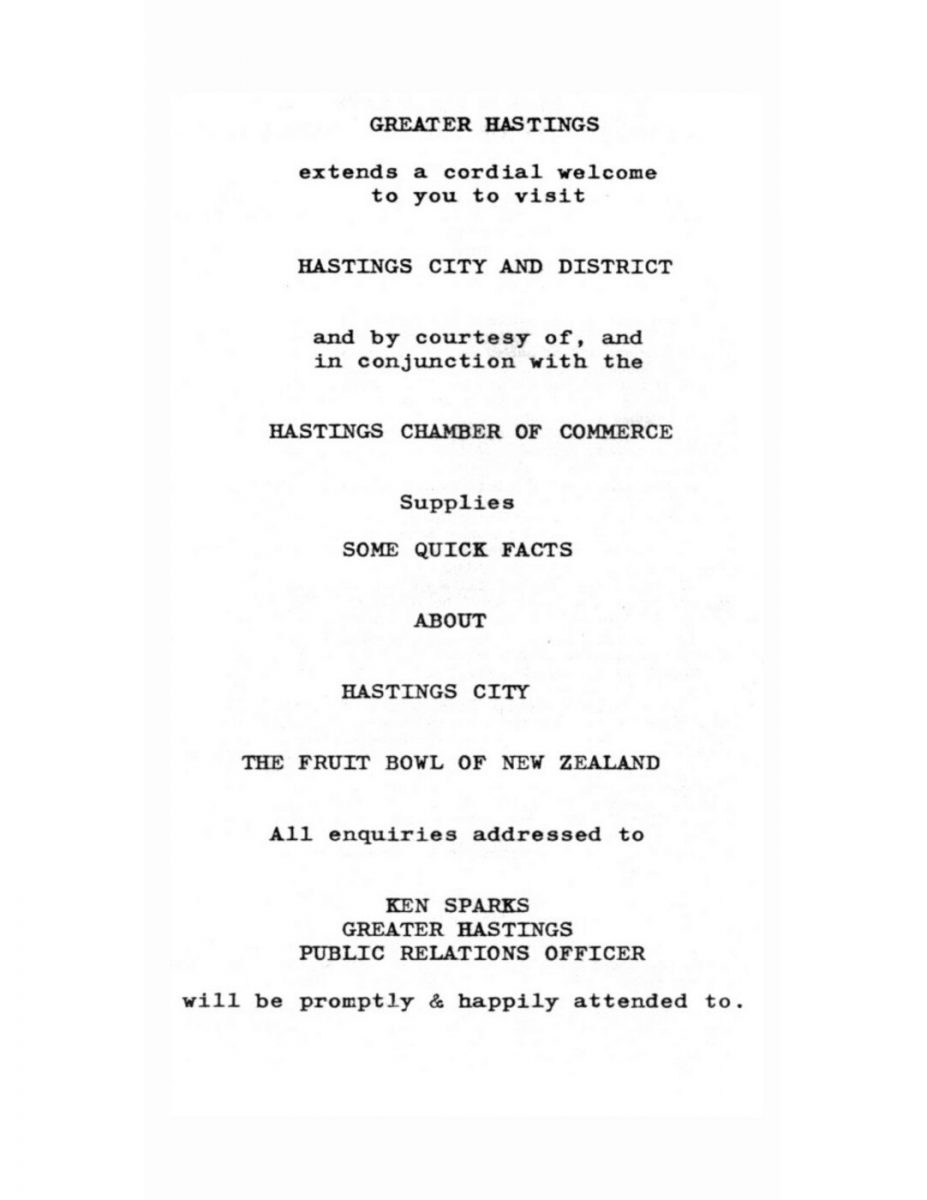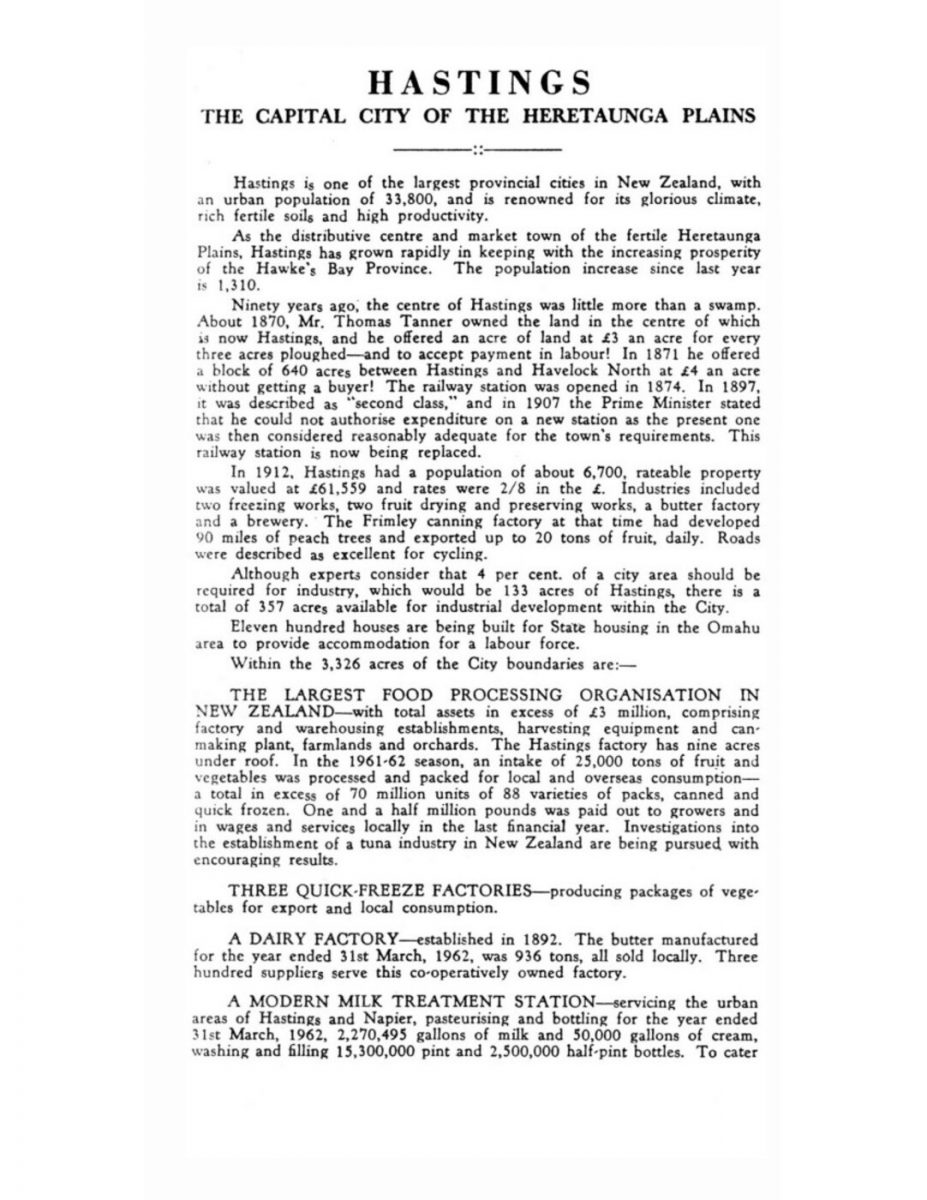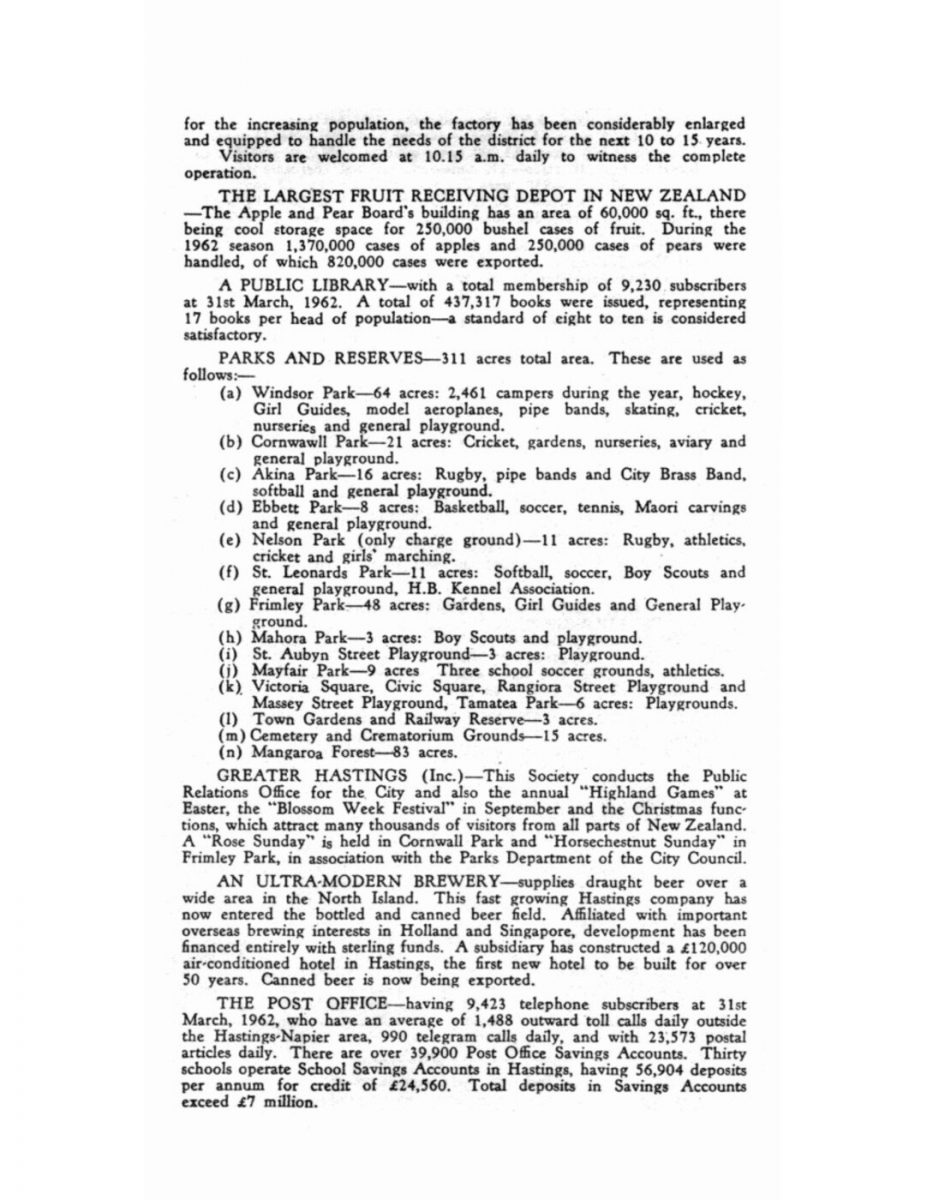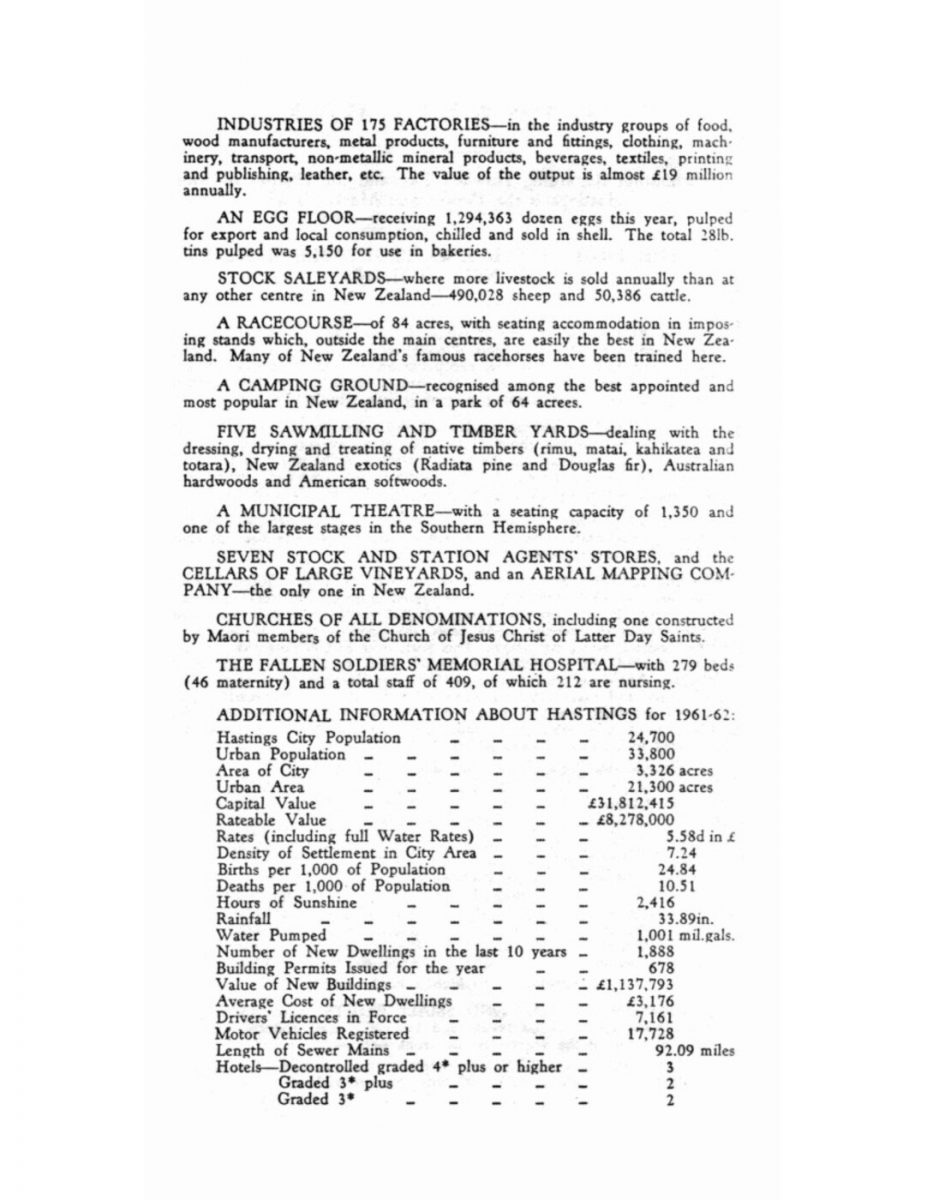- Home
- Collections
- POPPELWELL MD
- Greater Hastings, Fantasyland
- Facts About Hastings and Hawke's Bay 1962
Facts About Hastings and Hawke’s Bay 1962
GREATER HASTINGS
extends a cordial welcome
to you to visit
HASTINGS CITY AND DISTRICT
and by the courtesy of, and in conjunction with the
HASTINGS CHAMBER OF COMMERCE
Supplies
SOME QUICK FACTS
ABOUT
HASTINGS CITY
THE FRUIT BOWL OF NEW ZEALAND
All enquiries addressed to
KEN SPARKS
GREATER HASTINGS
PUBLIC RELATIONS OFFICER
will be promptly & happily attended to.

HASTINGS
THE CAPITAL CITY OF THE HERETAUNGA PLAINS
Hastings is one of the largest provincial cities in New Zealand, with an urban population of 33,800, and is renowned for its glorious climate, rich fertile soils and high productivity.
As the distributive centre and market town of the fertile Heretaunga Plains, Hastings has grown rapidly in keeping with the increasing prosperity of the Hawke’s Bay Province. The population increase since last year is 1,310.
Ninety years ago, the centre of Hastings was little more than a swamp. About 1870, Mr. Thomas Tanner owned the land in the centre of which is now Hastings, and he offered an acre of land at £3 an acre for every three acres ploughed – and to accept payment in labour! In 1871 he offered a block of 640 acres between Hastings and Havelock North at £4 an acre without getting a buyer! The railway station was opened in 1874. In 1897, it was described as “second class”, and in 1907 the Prime Minister stated that he could not authorise expenditure on a new station as the present one was then considered reasonably adequate for the town’s requirements. This railway station is now being replaced.
In 1912, Hastings had a population of about 6,700, rateable property was valued at £61,559 and rates were 2/8 in the £. Industries included two freezing works, two fruit drying and preserving works, a butter factory and a brewery. The Frimley canning factory at that time had developed 90 miles of peach trees and exported up to 20 tons of fruit, daily. Roads were described as excellent for cycling.
Although experts consider that 4 per cent. of a city area should be required for industry, which would be 133 acres of Hastings, there is a total of 357 acres available for industrial development within the City.
Eleven hundred houses are being built for State housing in the Omahu area to provide accommodation for a labour force.
Within the 3,326 acres of the City boundaries are:-
THE LARGEST FOOD PROCESSING ORGANISATION IN NEW ZEALAND – with total assets in excess of £3 million, comprising factory and warehousing establishments, harvesting equipment and can-making plant, farmlands and orchards. The Hastings factory has nine acres under roof. In the 1961-62 season, an intake of 25,000 tons of fruit and vegetables was processed and packed for local and overseas consumption – a total in excess of 70 million units of 88 varieties of packs, canned and quick frozen. One and a half million pounds was paid out to growers and in wages and services locally in the last financial year. Investigations into the establishment of a tuna industry in New Zealand are being pursued with encouraging results.
THREE QUICK-FREEZE FACTORIES – producing packages of vegetables for export and local consumption.
A DAIRY FACTORY – established in 1892. The butter manufactured for the year ended 31st March, 1962, was 936 tons, all sold locally. Three hundred suppliers serve this co-operatively owned factory.
A MODERN MILK TREATMENT STATION – servicing the urban areas of Hastings and Napier, pasteurising and bottling for the year ended 31st March 1962, 2,270,495 gallons of milk and 50,000 gallons of cream, washing and filling 15,300,000 pint and 2,500,000 half-pint bottles. To cater

for the increasing population, the factory has been considerably enlarged and equipped to handle the needs of the district for the next 10 to 15 years.
Visitors are welcomed at 10.15 a.m daily to witness the complete operation.
THE LARGEST FRUIT RECEIVING DEPOT IN NEW ZEALAND – The Apple and Pear Board’s building has an area of 60,000 sq. ft., there being cool storage space for 250,000 bushel cases of fruit. During the 1962 season 1,370,000 cases of apples and 250,000 cases of pears were handled, of which 820,000 cases were exported.
A PUBLIC LIBRARY – with a total membership of 9,230 subscribers at 31st March 1962. A total of 437,317 books were issued, representing 17 books per head of population – a standard of eight to ten is considered satisfactory.
PARKS AND RESERVES – 311 acres total area. These are used as follows:-
(a) Windsor Park – 64 acres: 2,461 campers during the year, hockey, Girl Guides, model aeroplanes, pipe bands, skating, cricket, nurseries and general playground.
(b) Cornwawll [Cornwall] Park – 21 acres: Cricket, gardens, nurseries, aviary and general playground.
(c) Akina Park – 16 acres: Rugby, pipe bands and City Brass Band, softball and general playground.
(d) Ebbett Park – 8 acres: Basketball, soccer, tennis, Maori carvings and general playground.
(e) Nelson Park (only charge ground) – 11 acres: Rugby, athletics, cricket and girls’ marching.
(f) St. Leonards Park – 11 acres: Softball, soccer, Boy Scouts and general playground, H.B. Kennel Association.
(g) Frimley Park – 48 acres: Gardens, Girl Guides and General Playground.
(h) Mahora Park – 3 acres: Boy Scouts and playground.
(i) St. Aubyn Street Playground – 3 acres: Playground.
(j) Mayfair Park – 9 acres: Three school soccer grounds, athletics.
(k) Victoria Square, Civic Square, Rangiora Street Playground and Massey Street Playground, Tamatea Park – 6 acres: Playgrounds.
(l) Town Gardens and Railway Reserve – 3 acres.
(m) Cemetery and Crematorium Grounds – 15 acres.
(n) Mangaroa Forest – 83 acres.
GREATER HASTINGS (Inc.) – This Society conducts the Public Relations Office for the City and also the annual “Highland Games” at Easter, the “Blossom Week Festival” in September and the Christmas functions, which attract many thousands of visitors from all parts of New Zealand. A “Rose Sunday” is held in Cornwall Park and “Horsechestnut [Horse chestnut] Sunday” in Frimley Park, in association with the Parks Department of the City Council.
AN ULTRA-MODERN BREWERY – supplies draught beer over a wide area in the North Island. This fast growing Hastings company has now entered the bottled and canned beer field. Affiliated with important overseas brewing interests in Holland and Singapore, development has been financed entirely with sterling funds. A subsidiary has constructed a £120,000 air-conditioned hotel in Hastings, the first new hotel to be built for over 50 years. Canned beer is now being exported.
THE POST OFFICE – having 9,423 telephone subscribers at 31st March 1962, who have an average of 1,488 outward calls daily outside the Hastings-Napier area, 990 telegram calls daily, and with 23,573 postal articles daily. There are over 39,900 Post Office Savings Accounts. Thirty schools operate School Savings Accounts in Hastings, having 56,904 deposits per annum for credit of £24,560. Total deposits in Savings Accounts exceed £7 million.

INDUSTRIES OF 175 FACTORIES – in the industry groups of food, wood manufacturers, metal products, furniture and fittings, clothing, machinery, transport, non-metallic mineral products, beverages, textiles, printing and publishing, leather, etc. The value of the output is almost £19 million annually.
AN EGG FLOOR – receiving 1,294,363 dozen eggs this year, pulped for export and local consumption, chilled and sold in shell. The total 28lb. tins pulped was 5,150 or use in bakeries.
STOCK SALEYARDS – where more livestock is sold annually than at any other centre in New Zealand – 490,028 sheep and 50,386 cattle.
A RACECOURSE – of 84 acres, with seating accommodation in imposing stands which, outside of the main centres, are easily the best in New Zealand. Many of New Zealand’s famous racehorses have been trained here.
A CAMPING GROUND – recognised among the best appointed and most popular in New Zealand, in a park of 64 acres.
FIVE SAW MILLING AND TIMBER YARDS – dealing with the dressing, drying and treating of native timbers (rimu, matai, kahikatea and totara), New Zealand exotics (Radiata pine and Douglas fir), Australian hardwoods and American softwoods.
A MUNICIPAL THEATRE – with a seating capacity of 1,350 and one of the largest stages in the Southern Hemisphere.
SEVEN STOCK AND STATION AGENTS’ STORES, and the CELLARS OF LARGE VINEYARDS, and an AERIAL MAPPING COMPANY – the only one in New Zealand.
CHURCHES OF ALL DENOMINATIONS, including one constructed by Maori members of the Church of Jesus Christ of Latter Day Saints.
THE FALLEN SOLDIERS’ MEMORIAL HOSPITAL – with 279 beds (46 maternity) and a total staff of 409, of which 212 are nursing.
ADDITIONAL INFORMATION ABOUT HASTINGS FOR 1961-62:
Hastings City Population 24,700
Urban Population 33,800
Area of City 3,326 acres
Urban Area 21,300 acres
Capital Value £31,812,415
Rateable Value £8,278,000
Rates (including full Water Rates) 5.58d in £
Density of Settlement in City Area 7.24
Births per 1,000 of Population 24.84
Deaths per 1,000 of Population 10.51
Hours of Sunshine 2,416
Rainfall 33.89in.
Water Pumped 1,001 mil.gals.
Number of New Dwellings in the last 10 years 1,888
Building Permits Issued for the year 678
Value of New Buildings £1,137,793
Average Cost of New Dwellings £3,176
Drivers’ Licences in Force 7,161
Motor Vehicles Registered 17,728
Length of Sewer Mains 92.09 miles
Hotels – Decontrolled graded 4* plus or higher 3
Graded 3* plus 2
Graded 3* 2

HAWKE’S BAY
Information Regarding Hawke’s Bay and the District of which Hastings is the centre and Market Town
THE FRUIT BOWL AND VEGETABLE BASKET OF NEW ZEALAND
SHEEP run totalled over 5¾ million at June, 1962, of which 3¾ million were breeding ewes, 9,000 rams, 296 wethers and 1½ million hoggets, there being 3,294 sheep owners, occupying an area of 2¾ million acres of farmland. More sheep are run to the acre in Hawke’s Bay than elsewhere in New Zealand. The lambing percentage is nearly 100 over-all.
WOOL sold in 1961-62 totalled 209,430 bales – the greatest number in New Zealand – realising about £11,370,000 at an average of £54 a bale – 3/3 a lb. This wool, among the finest crossbred in the world, is bid for by buyers from all over the world. The district is also a most important centre for scoured wools, 16,432 bales realising £9,32,310 at 4/3 a lb.
CATTLE: There are nearly 1,000 dairy farms of over 90,000 acres carrying 43,000 dairy cows in milk. In addition, there is a total of about 465,000 beef cattle, mostly Aberdeen Angus.
ORCHARDS: For the 1962 season, over 2½ million bushel cases of fruit were harvested from the 372 registered orchards (50 trees and over). With over 230,000 pip fruit trees, 150,000 stone fruit trees and 1,384 citrus fruit trees covering 3,454 acres, the yield is easily the highest in New Zealand, as set out below. This year, over 820,000 cases of pip fruit were exported. Pallet loading (40-bushel cases) enabled fruit to be taken from the Apple and Pear Board’s cool store in Hastings direct to the ship’s cool space and then direct to many countries all over the world, which ensured the fruit being in prime condition when bought by housewives thousands of miles away. Fruit opens up in London in the same condition as loaded in Hastings, New Zealand.
Approximate average yields per acre are as follows:-
Bushels
*Apples 900
Peaches 350
Plums 240
Quinces 640
Pears 700
Nectarines 400
Cherries 150
Apricots 100
The 1962 production has been:-
Bushels
Apples 1,475,000
Peaches 425,500
Plums 82,850
Quinces 7,000
Pears 350,000
Nectarines 12,000
Cherries 1,450
Apricots 3,700
*Probably the highest in the world!
MARKET GARDENS AND SMALL FRUITS: Over 13,000 acres were planted for the 1962 season and the yields and production for this season of some of the vegetables and fruits were:-
Peas: 7,000 acres – 9,000 tons – average yield per acre 1 1/2 tons.
Asparagus: 1,700 acres – 1,100 tons – average yield per acre 1 ton.

Tomatoes: 960 acres – 20,000 tons – average yield per acre 20 tons.
Grapes: 600 acres – 3,500 tons – average yield per acre 6 tons.
Beans: 1,400 acres – 5,100 tons – average yield per acre 3 1/2 tons.
Potatoes: 1,800 acres – 15,000 tons – average yield per acre 8 tons.
Sweet Corn: 110 acres – 372 tons – average yield per acre 3 tons.
Carrots: 60 acres – 950 tons – average yield per acre 15 tons.
Berry Fruit: 75 acres – 120 tons – average yield per acre 1 1/2 tons.
Onions: 300 acres – 300 tons – average yield per ace 1 ton.
Fruits and vegetables of all kinds are grown and despatched to all parts of New Zealand as well as being canned, deep frozen and bottled for export and local consumption. An additional 463 acres of mixed vegetables produce 3,500 tons.
WINERIES: There are ten large wineries in the district, some being of recent construction and of very modern design. Ten years ago there were 84,000 vines planted – now there are over 170,000 vines.
CORN AND GRASS SEED: The area sown down in wheat for 1962 is over 4,500 acres, for barley 1,750 acres, rye corn 80 acres, oats 300 acres and Lucerne 10,000 acres. Grass seed production exceeds 4 million pound annually, the yield of perennial rye grass being the highest in New Zealand at 487lbs. per acre.
Just outside the present Hastings boundaries are:-
TWO OF THE LARGEST FREEZING WORKS in New Zealand which kill for export over 100,000,000 pounds annually of the finest lamb and mutton, daily killings during the season exceeding 28,000 lambs. Seventy-five thousand head of cattle are killed annually for the chiller beef trade. This season was a record one with over 2½ million carcases killed to date.
THE HAWKE’S BAY AGRICULTURAL AND PASTORAL SOCIETY’S SHOW GROUNDS, regarded as the most beautiful in New Zealand, with an area of 133 acres. The 1961 annual Show was the 102nd, with an attendance on “People’s Day” of over 40,000. At the December 1961 Ram Fair there were entries of 891 flock Romneys, 1,712 flock Southdowns and 139 other breeds.
THE HAWKE’S BAY AND EAST COAST AERO CLUB AND AERODROME AT BRIDGE PA: Founded in 1928 following the visit of Sir Charles Kingsford-Smith, the Club now has seven aircraft – a Cessna 180, a Piper P.A. 18, two Miles Whitney Straights and three Tiger Moths.
The aerodrome is also the headquarters of eleven aerial topdressing and spraying companies and their aircraft, and also the N.Z. Aerial Mapping Company, making more than thirty planes using the aerodrome.
The information and statistics given in this Booklet is acknowledged gratefully and we thank the following for their assistance:-
Senior Instructor in Horticulture, Department of Agriculture, Hastings; Hawke’s Bay Woolbrokers’ Association; Hawke’s Bay Agricultural and Pastoral Society; the Government Statistician; Dairy Produce Grader, Department of Agriculture; J. Wattie Canneries Ltd.; the Manager, Apple and Pear Marketing Board; the Manager, Hastings Milk Treatment Station; the Postmaster; Heretaunga Co-op Dairy Company Limited; the Manager, Egg Marketing Floor; Hastings City Council for the Annual Reports from the Librarian, City Engineer, Senior Traffic Officer and Superintendent of Parks.
Supplied with the Compliments of
GREATER HASTINGS PUBLIC RELATIONS OFFICE.

Non-commercial use

This work is licensed under a Attribution-NonCommercial 3.0 New Zealand (CC BY-NC 3.0 NZ).
Commercial Use
Please contact us for information about using this material commercially.Can you help?
The Hawke's Bay Knowledge Bank relies on donations to make this material available. Please consider making a donation towards preserving our local history.
Visit our donations page for more information.
Business / Organisation
Greater HastingsFormat of the original
Typed documentDate published
1962People
- Sir Charles Kingsford-Smith
- Ken Sparks
- Thomas Tanner










Do you know something about this record?
Please note we cannot verify the accuracy of any information posted by the community.